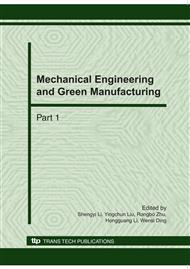[1]
J. Borenstein and Y. Koren, Obstacle avoidance with ultrasonic sensors, IEEE Journal of Robotics and Automation, vol. 4, no. 2, April 1988, pp.213-218.
DOI: 10.1109/56.2085
Google Scholar
[2]
LIANG Yu-ming and XU Li-hong, Research and design of multi-sensor ranging system on mobile robot, Computer Applications, vol. 4, no. 2, Jine 2008, pp.340-343. Fig. 4 Simulation of obstacles avoidance with Behavior-based fuzzy control.
Google Scholar
[3]
H. Marref and C. Barret, Sensor-based fuzzy navigation of an autonomous mobile robot in an indoor environment, Control Engineering Practice 8(2000), pp.757-768.
DOI: 10.1016/s0967-0661(99)00200-2
Google Scholar
[4]
S. Thongchai and K. Kawamura, Application of fuzzy control to a sonar-based obstacle avoidance mobile robot, in Proceedings of the IEEE International Conference on Control Applications, Anchorage, Alaska, USA, Sept. 25-27, 2000, pp.425-430.
DOI: 10.1109/cca.2000.897461
Google Scholar
[5]
Yang Jingdong, Hong Bingrong, Piao Songhao, The algorithm of obstacle avoidance based on fuzzy behavior fusion for mobile robot, J. Huazhong Univ. of Sci. & Tech. (Natural Science Edition), vol. 36, sup. I, October 2008, pp.310-313, 320.
Google Scholar
[6]
S. X. Yang and M. Meng, Neural network approaches to dynamic collision-free robot trajectory generation, IEEE Transactions on System, Man, Cybernetics, vol. 3l, June 2001, pp.302-318.
DOI: 10.1109/3477.931512
Google Scholar
[7]
A. Saffiotti, The uses of fuzzy logic in autonomous robot navigation, Soft Comput., vol. 1, no. 4, 1997, pp.180-197.
Google Scholar
[8]
Manuel Mucientes and Jorge Casillas, Quick Design of Fuzzy Controllers With Good Interpretability in Mobile Robotics, IEEE Transactions on Fuzzy System, vol. 15, no. 4, August 2007, pp.636-651.
DOI: 10.1109/tfuzz.2006.889889
Google Scholar
[9]
M. Mucientes, R. Iglesias, C. V. Regueiro, etc., A fuzzy temporal rule-based velocity controller for mobile robotics, Fuzzy Sets Syst., vol. l34, 2003, pp.83-99.
DOI: 10.1016/s0165-0114(02)00231-2
Google Scholar
[10]
R. C. Arkin, Behavior-Based Robotics. MIT Press, Cambridge Massachusetts, (1998).
Google Scholar
[11]
Simon X. Yang, Hao Li, and Max Meng, Fuzzy Control of a Behavior-Based Mobile Robot, in 2003 IEEE International Conference on Fuzzy Systems, 2003, pp.319-324.
DOI: 10.1109/fuzz.2003.1209382
Google Scholar
[12]
S. Thongchai, S. Suksakulchai, D. M. wilkes, etc., Sonar Behavior-Based Fuzzy Control for a mobile robot, in Proceedings of the IEEE International Conference on Control Applications, Anchorage, Alaska, USA, Sept. 25-27, 2000, pp.3532-3537.
DOI: 10.1109/icsmc.2000.886556
Google Scholar
[13]
Petru Rusu, Emil M. Petriu, Thom E. Whalen, etc., Behavior-Based Neuro-Fuzzy Controller for Mobile Robot Navigation, IEEE Transactions on Instrumentation and Measurement, vol. 52, no. 4, August 2003, pp.1335-1340.
DOI: 10.1109/tim.2003.816846
Google Scholar
[14]
Sharp IR Rangers Informationn, 2008, Available: http: /www. acroname. com/robotics/info.
Google Scholar
[15]
Linearizing Sharp Ranger Data, 2006, Available: http: /www. acroname. com/robotics/info.
Google Scholar
[16]
Liang Yuming, Xu Lihong, Zhu Bingkun, Ranging Sensors Measurement Adaptive Weighted Fusion On-line, Computer measurement & Control, vol. 17, no. 7, 2009, pp.1447-1449.
Google Scholar
[17]
Zeng Guangji, Hu Junan, Wang Dong, etc., Fuzzy Control Theory and Engineering Applications. Huazhong University of Science and Technology Press, Wuhan, China, (2006).
Google Scholar


